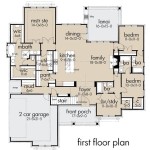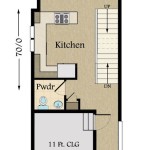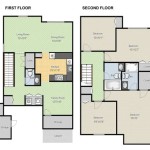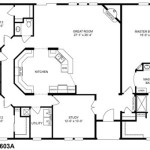Cabin Style Home Floor Plans: A Guide to Rustic Living
Cabin style home floor plans evoke images of cozy retreats nestled in nature, offering a sense of warmth, simplicity, and connection to the outdoors. These plans prioritize comfortable living spaces, natural materials, and features that maximize the enjoyment of the surrounding environment. Understanding the key elements that define cabin style floor plans is crucial for anyone considering building or renovating a home with this aesthetic.
The appeal of cabin style homes lies in their ability to blend functionality with a rustic charm. They often incorporate open floor plans, emphasizing communal spaces for gathering and relaxation. The integration of natural light, through large windows and strategically placed skylights, further enhances the connection to the surrounding landscape. The use of materials like wood, stone, and exposed beams is central to creating the characteristic cabin aesthetic.
While the term "cabin" may conjure thoughts of small, isolated structures, modern cabin style homes can range in size from compact getaways to spacious family residences. The common thread that connects them is the emphasis on creating a comfortable, inviting, and aesthetically pleasing living environment that prioritizes the natural world.
Key Point 1: Common Characteristics of Cabin Style Floor Plans
A defining characteristic of cabin style home floor plans is the open concept living area. This typically combines the living room, dining area, and kitchen into a single, unified space. This design promotes a sense of togetherness and facilitates natural light flow throughout the home. The open layout is particularly advantageous in smaller cabins, maximizing the perceived space and creating a more inviting atmosphere.
Fireplaces are another hallmark feature often found in cabin style homes. Positioned as a focal point within the living area, the fireplace adds warmth, both literally and figuratively, to the space. Fireplaces can be crafted from stone, brick, or wood, further contributing to the rustic aesthetic. The presence of a fireplace encourages relaxation and creates a cozy ambiance, particularly during colder months.
Lofts are frequently incorporated into cabin designs, serving as versatile spaces for sleeping, storage, or recreational activities. They often feature exposed beams and wood finishes, adding to the cabin's rustic charm. Lofts can be accessed via ladders or stairs, and they provide a unique vantage point overlooking the main living area. These elevated spaces offer a sense of privacy and can be particularly appealing to children and guests.
Porches and decks are integral components of cabin style living, extending the living space to the outdoors. These outdoor areas provide opportunities for relaxation, dining, and enjoying the surrounding scenery. Porches and decks are often constructed from wood and may feature railings, pergolas, or other architectural elements that enhance their aesthetic appeal. They serve as a transitional space between the interior and exterior, blurring the boundaries between the built environment and the natural world.
Mudrooms are practical additions frequently included in cabin floor plans, especially in regions with inclement weather. This space provides a designated area for storing coats, shoes, and other outdoor gear, helping to keep the main living areas clean and organized. Mudrooms can be equipped with benches, shelving, and hooks to maximize their functionality. They are particularly useful for families who enjoy outdoor activities and require a convenient space to manage their gear.
Key Point 2: Material Selection for Cabin Style Homes
The choice of materials plays a pivotal role in establishing the cabin aesthetic. Wood is undoubtedly the most prominent material, used extensively for framing, siding, flooring, and interior finishes. Different types of wood can be employed, each contributing a unique character to the space. Pine, cedar, and fir are popular choices due to their durability, affordability, and natural beauty. The use of reclaimed wood can add an element of history and authenticity to the design.
Stone is another material frequently incorporated into cabin style homes. It can be used for fireplaces, exterior accents, foundation walls, and walkways. Stone lends a sense of permanence and solidity to the structure, grounding it in its natural surroundings. The use of locally sourced stone can further enhance the connection to the region's unique character.
Exposed beams are a common architectural feature in cabin design, adding visual interest and showcasing the structural integrity of the building. These beams can be made from wood or metal, and they are often left unfinished to highlight their natural texture and grain. Exposed beams contribute to the rustic charm of the cabin and can create a sense of spaciousness and height.
Metal accents, such as hardware, lighting fixtures, and roofing materials, can complement the wood and stone elements of a cabin. Metal adds a touch of modernity and can provide a contrasting texture to the natural materials. Darker metals, like wrought iron or bronze, are often preferred for their rustic appearance. Careful consideration of the color and finish of metal accents can enhance the overall aesthetic of the cabin.
Proper insulation is crucial for maintaining a comfortable indoor environment in a cabin, particularly in colder climates. Natural insulation materials, such as sheep's wool, cellulose, or straw bales, can be used to improve energy efficiency and reduce heating costs. These materials are also environmentally friendly and can contribute to a healthier indoor air quality.
Key Point 3: Adapting Cabin Style to Modern Living
While cabin style homes often evoke a sense of rustic simplicity, they can be adapted to incorporate modern amenities and technologies. Integrating smart home features, such as automated lighting, temperature control, and security systems, can enhance comfort and convenience without compromising the cabin's aesthetic. Careful planning is essential to ensure that these modern elements seamlessly blend into the overall design.
Energy efficiency is an increasingly important consideration in modern cabin design. Employing sustainable building practices, such as using renewable energy sources, installing energy-efficient appliances, and optimizing insulation, can significantly reduce the environmental impact of the home. Solar panels, wind turbines, and geothermal systems can be integrated into the design to provide clean and sustainable energy.
Universal design principles can be applied to cabin style homes to ensure accessibility for individuals of all ages and abilities. This may involve incorporating wider doorways, ramps, and accessible bathrooms. Universal design elements can enhance the comfort and functionality of the cabin for everyone, regardless of their physical limitations.
Customization is key to creating a cabin style home that reflects the unique needs and preferences of its occupants. Working with an architect or designer to create a floor plan that optimizes the use of space and incorporates personal touches can result in a truly individualized living environment. Custom cabinetry, built-in shelving, and unique architectural details can enhance the character and functionality of the cabin.
The integration of indoor and outdoor spaces is a hallmark of modern cabin design. Large windows, sliding doors, and outdoor living areas blur the boundaries between the interior and exterior, allowing residents to fully appreciate the surrounding natural environment. Outdoor kitchens, fire pits, and hot tubs can further enhance the enjoyment of the outdoor space.
In conclusion, cabin style home floor plans offer a versatile and appealing approach to residential design. By understanding the key characteristics, material selections, and adaptation possibilities, individuals can create comfortable, inviting, and aesthetically pleasing living spaces that celebrate the natural world.

Cabin Style House Plan 3 Beds 2 Baths 1659 Sq Ft 47 437 In 2024 Plans Lake Sims

Stone Mountain Cabin Plans Tiny House Blog Sims

Happy Floorplanfriday The Madison From Southland Log Homes Is A One Level Ranch Style Ho House Plans Home Floor Cabin

Small Cottage House Plans With Modern Open Layouts Houseplans Blog Com

Cabin Vacation Style Home Plan Getaways

Small Cottage Plan With Walkout Basement Floor

Dog Trot House Plan Dogtrot Home By Max Fulbright Designs Plans Cottage

Rustic Cottage House Plan Small Cabin

Small Cabin House Plans With Loft And Porch For Fall Houseplans Blog Com

Standout Log Cabin Plans Escape To An Earlier Gentler Time








